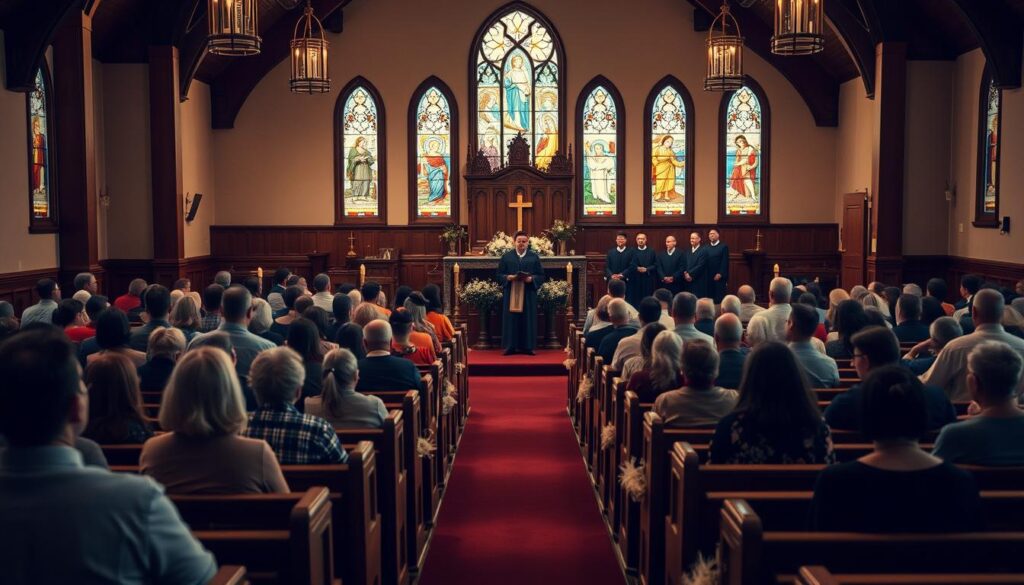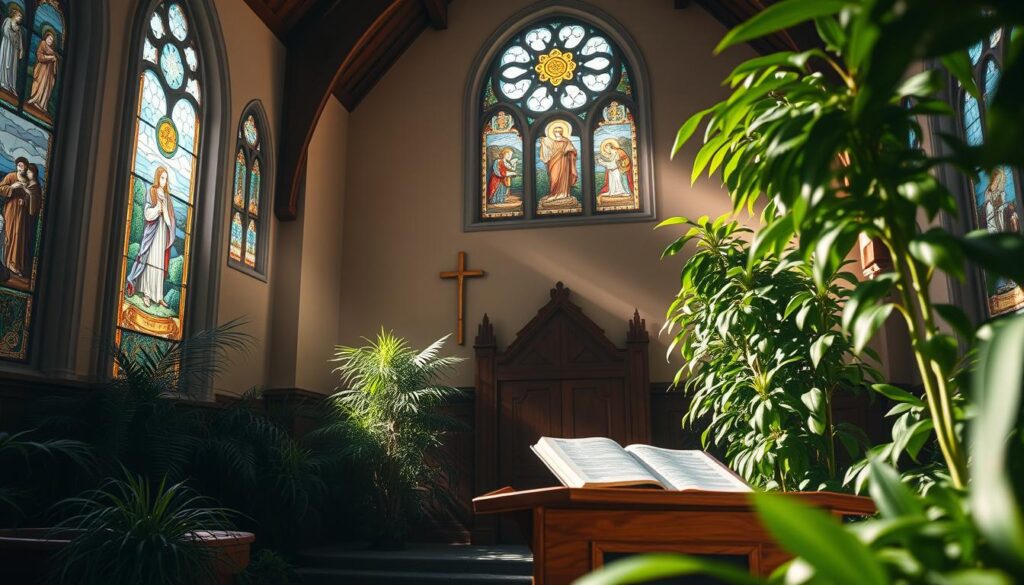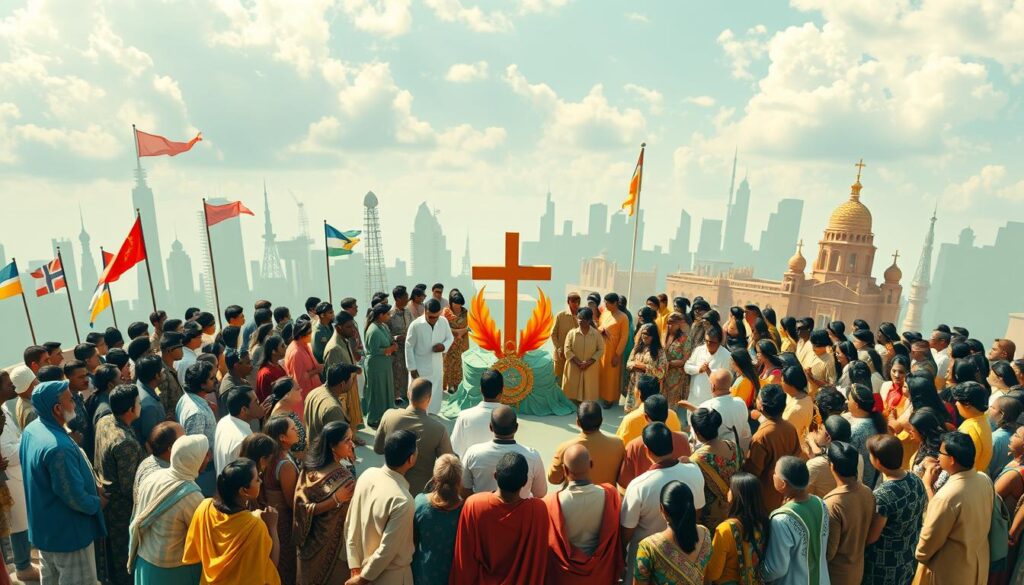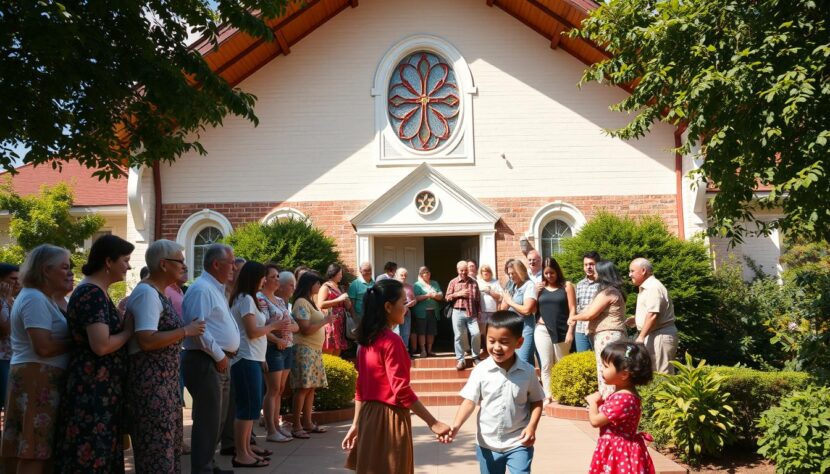The Methodist Church was founded by John and Charles Wesley. It’s key in shaping Christian thought and community service. With nearly 8 million members in the U.S. and over 4 million worldwide, it has a rich history and big influence1.
The church started in 1968 but has roots from 1769 in Maryland1. It focuses on personal faith, community outreach, and social justice. Knowing Methodist beliefs helps understand its importance worldwide.
This guide explores the Methodist Church deeply. It covers its principles, practices, and history. It also looks at its values and mission today.
Key Takeaways
- Methodism has nearly 8 million members in the U.S. and over 12 million globally.
- The movement began with a small group of individuals seeking spiritual guidance in London in 1739.
- Members adhere to a rule emphasizing good works and community support.
- Local societies operate with structured support systems, including classes and bands.
- Principles of accountability and spiritual well-being are vital to Methodist community life.
What is the Methodist Church?
The Methodist Church is a welcoming community that started in the 18th century. It emerged from a revival within Anglicanism, aiming to renew faith through a systematic approach. John and Charles Wesley, the founders, are key figures in the methodist denomination for their roles and practices.
History and Origins
Methodism grew in Britain from 1760 to 1820, especially among the working class. It brought about social change and community growth2. John Wesley had a deep evangelical conversion in 1738, which sparked the movement.
This event led Wesley and his followers to create spaces for support and spirituality. By 2022, the United Methodist Church (UMC) had about 5,424,175 members in the U.S. and 9,984,925 worldwide, with 29,746 churches3.
Key Beliefs and Principles
At the heart of methodist beliefs is the belief that God is accessible to all. This creates an inclusive and accepting environment. Regular class meetings are a key part of Methodism, showing their commitment to community and accountability2.
Methodists have historically practiced weekly fasting and banned gambling to uphold personal standards. The church also values hymns and communal singing, thanks to Charles Wesley’s musical contributions.
Core Doctrines of Methodism
The core teachings of Methodism are based on scripture and the idea of grace. These teachings shape the church’s identity and guide its members’ faith. Methodism sees grace as available to everyone, giving people the freedom to accept God’s call.
Grace and Free Will
Methodist theology centers on God’s grace being freely given to all. This grace offers a clear path to salvation. It encourages individuals to make choices about their faith.
The doctrine reflects the Arminian view, which stresses human choice. It says people can accept or reject God’s grace. This idea comes from early Methodist discussions4 and John Wesley’s sermons5.
Scripture’s Role in Methodism
Scripture is key in shaping Methodist beliefs and ethics. The Articles of Religion state the Bible is essential for our salvation4. This shows its vital role in personal and community life.
The use of the Apostles Creed in baptism highlights scripture’s importance in worship5. Reading and studying the Bible helps deepen faith. It ensures Methodists live according to scripture’s teachings.
The Structure of the Methodist Church
The Methodist Church has a detailed and community-focused structure. It centers around local churches, which are key in spreading the church’s mission. Each local church is guided by bishops, forming a charge that can include one or more congregations in a district. This setup empowers local churches and encourages collaboration and sharing of resources among them.
Local Churches
Every local church is part of a district, which is an administrative group in a specific area. In the United States, there are five geographic jurisdictions. Each has eight to fifteen annual conferences6. Local churches have equal voting rights for laypeople and clergy, ensuring balanced decision-making7. The Book of Discipline outlines these roles and responsibilities, helping local churches operate well and follow church policies6.
Annual Conferences
Annual conferences are the Methodist Church’s main organizing body. They hold yearly meetings to discuss ministry direction and budgets8. These conferences have delegates from both lay and clergy groups, ensuring fair representation8. The General Conference, held every four years, is the church’s top legislative body. It includes around 860 delegates from worldwide United Methodist conferences, showing the church’s global reach7. This conference is key to the church’s mission, promoting collaboration and accountability8.
Worship Practices in Methodism
Worship in the Methodist Church is a mix of old and new. It makes church services fun for everyone, no matter their age. This way, people of all kinds can find a place to connect with their faith.
Traditional Worship Styles
Traditional Methodist services include hymns, liturgy, and sacraments like Holy Communion. These services follow a pattern set by John Wesley. They balance order and freedom in worship.
The Sunday service has a special pattern. It includes offering bread and wine, giving thanks, breaking bread, and sharing the elements9. Hymns by Charles Wesley are key, alongside modern and diverse hymns9.
Contemporary Worship Options
Today, Methodist worship has changed to meet modern needs. While hymns are still important, nonliturgical services are growing. In the U.S., bishops lead every four years, guiding these changes9.
Public worship is vital for building community and spiritual growth. It shows Methodist’s dedication to welcoming everyone10.

The Methodist Social Creed
The Methodist Church is deeply committed to social justice. This is shown in its Social Creed. It highlights the need to help those who are marginalized and tackle big social problems.
Social Justice Initiatives
The Methodist Church believes in fighting for justice. It works on reducing poverty, promoting racial equality, and protecting the environment. Churches team up with local groups to help those in need.
They also partner with schools and governments. This is to make society more just and fair for everyone.
Community Engagement and Outreach
The Methodist community is very involved in its neighborhoods. They run outreach programs to tackle local and global issues. These efforts help build stronger community bonds and empower people to fight for justice.
Methodist Theology
Methodist theology has its roots in Arminianism. This view says people have free will to accept God’s grace. This shapes many beliefs in Methodism. A key part is sanctification, a journey to become holy and follow Christ’s mission.
The Importance of Arminianism
Arminianism is key to Methodist theology. It says God’s grace is available to all, but people must choose to accept it. Methodists believe in free will, making them active in their spiritual journey. This belief makes believers feel responsible for growing in faith.
Understanding Sanctification
Sanctification is a lifelong journey to spiritual growth in Methodist theology. It’s not just one event but a continuous process. Grace helps people overcome sin and become holy. John Wesley, Methodism’s founder, believed sanctification deepens our relationship with God and changes us.
Through personal and group practices, believers aim to live like Christ. This is a key part of Methodist theology.

| Key Elements of Methodist Theology | Description |
|---|---|
| Arminianism | Emphasizes human free will in accepting God’s grace. |
| Grace | Divine assistance given to humans for regeneration and sanctification. |
| Sanctification | The process of spiritual growth and transformation toward holiness. |
“The goal of holiness is to be transformed into the likeness of Christ, living out His love in the world.”
Grace is central to Methodist beliefs, shaping individual and community faith. These elements work together, inspiring many on their spiritual journeys111213.
Prominent Methodist Leaders
Methodist leaders have greatly influenced religious practices and social issues. They have woven a rich tapestry of influence and commitment through history. Each leader, past or present, adds their unique touch to the story of Methodism. This section looks at John Wesley’s lasting impact and the work of today’s leaders.
John Wesley’s Legacy
John Wesley, the founder of Methodism, emphasized personal faith and social responsibility. His teachings on grace, community, and helping the marginalized set a strong foundation. Wesley made complex ideas easy to understand, helping Methodism grow during his time and beyond.
Contemporary Influencers
Today, Methodist leaders tackle big global issues. They talk about climate change, human rights, and working with other faiths. Leaders like Bishop Michael Curry and Rev. Adam Hamilton are at the forefront, pushing for justice and kindness.
| Leader Name | Contribution | Focus Area |
|---|---|---|
| John Wesley | Established foundational doctrines and practices | Personal holiness and social justice |
| Bishop Michael Curry | Promotes love and unity | Human rights and social equity |
| Rev. Adam Hamilton | Community engagement through service | Interfaith dialogue and outreach |
These leaders keep Methodism alive and growing, staying true to its roots. Their work shows how Methodism adapts to today’s world while holding onto its core values.
Methodist Education and Formation
Education is key in the Methodist community, focusing on both spiritual and academic growth. Programs like Sunday School and discipleship help people dive into their faith. Methodist-affiliated colleges also play a big role in creating a well-rounded learning environment.
Sunday School and Discipleship
Sunday School helps people of all ages learn more about their faith. It offers lessons and activities that make biblical teachings relatable. Discipleship programs help deepen this connection, encouraging a strong commitment to Methodist values.
The first Sunday School service was held on March 15, 1851, at Palo Alto school. This shows the long history of methodist education in the community14.
Higher Education Institutions
Many universities and colleges are linked to the United Methodist Church. They offer a mix of academic learning and spiritual growth. These schools focus on values-driven education, where faith and learning meet.
The first school in the Village of Ononwa was built in 1860. This marked a big step forward in methodist education15. Today, these efforts continue, supporting both academic and spiritual growth. Church picnics, for example, have seen up to 1,200 attendees, showing the community’s vibrancy14.

The Role of Tradition in Methodism
The methodist tradition is key in shaping faith and community within the church. The Book of Discipline outlines the church’s governance, practices, and beliefs. It ensures everyone follows the same teachings and provides a clear structure for church leadership.
The Book of Discipline
This text does two important things. It keeps the church’s history alive and guides today’s practices. It shows the church’s values, like the importance of personal salvation and helping others16. It helps pass down Christian traditions from one generation to the next, showing a commitment to understanding the gospel17.
Liturgical Practices
Liturgical practices in Methodism are shaped by tradition and The Book of Discipline. Methodists celebrate sacraments like baptism and Holy Communion, seeing them as special times to connect with God16. These rituals also show a growing respect for different cultures, especially in addressing social issues faced by marginalized groups17.
Methodism Around the World
Methodism has grown into a big global movement. It has a rich diversity among its communities. With over 40.5 million members in 138 countries, it thrives in many cultures, spreading Christian values18.
In Africa, Methodism has grown by blending local customs with faith. This creates a vibrant faith community. Methodism adapts to different cultures, uniting its followers worldwide to spread the Gospel.
Global Methodist Communities
In the late 19th and early 20th centuries, Methodism spread globally19. Leaders like John Wesley and Francis Asbury led this effort. Today, over 300 United Methodist missionaries work in 60 countries, showing Methodist presence on four continents20.
These communities focus on spiritual and physical needs. This shows the church’s commitment to helping people fully.
Ecumenical Relationships
The global Methodist community values partnerships with other Christian groups18. The Methodist Church helped start the British Council of Churches in 1942. It also joined the World Council of Churches in 194818.
These partnerships show a desire for unity in worship and mission. The church faces challenges like rising nationalism and cultural changes19.

| Region | Membership (in millions) | Key Developments |
|---|---|---|
| Africa | 12 | Rapid growth and self-governing branches |
| Asia | 4 | Political movements leading to independent congregations |
| South America | 2 | Emergence of indigenous-led Methodist communities |
| North America | 7 | Historical roots and ongoing mission work |
Challenges Facing the Methodist Church
The Methodist Church is going through a tough time. It’s dealing with big challenges like faith and morality issues. In 2022, a big split happened when some conservative Methodists started the Global Methodist Church. This change has really shaken the UMC’s structure21.
There are also efforts to change the church from within. But these changes often run into old traditions and different views on faith.
Faith and Morality Debates
Discussions about faith and morality have put the church’s teachings under a microscope. The General Conference in 2024 will be key. It will tackle LGBTQ+ rights, a topic that has caused a lot of debate21.
In recent years, the church has lost a lot of members. Almost 220,000 left in 2020. This shows how society is changing and younger people are not as religious22. The church is facing a big test as it decides on its core values.
Denominational Splits
Denominational splits show the Methodist Church’s big challenges. Over 7,600 churches have left, which is about 25% of all United Methodist churches21. These splits are due to the church’s complex rules and disagreements within.
Money is also a big problem. The church has a lot of debt and is expected to lose another million members by 202522. This crisis of faith and the church’s leadership are big questions for the UMC’s future.
| Year | Membership Change | Significant Events |
|---|---|---|
| 2020 | -220,000 | Major departures amid rising disputes over LGBTQ+ issues |
| 2022 | N/A | Formation of the Global Methodist Church |
| 2024 (Projected) | -1,000,000 | Anticipated losses by the end of the year |
| 2024 | N/A | General Conference scheduled for late April |
Getting Involved in the Methodist Church
Starting your journey with the Methodist community means finding a local church that matches your beliefs. The United Methodist Church (UMC) has over 30,000 congregations in the U.S. They offer many chances for worship and friendship for different spiritual needs23. By visiting different churches, you can find a place where you feel at home and make friends who share your faith.
Finding Your Local Church
After finding your local church, dive into the many programs and missions they offer. Churches often have community projects where you can help out. By doing Methodist service, you build connections and deepen your faith as you work on missions that reflect John Wesley’s teachings24.
Volunteer Opportunities and Missions
Joining volunteer work can make your spiritual journey richer. Helping out at church or going on missions abroad can grow your faith. It also shows your commitment to the Methodist values of justice and helping others25.
FAQ
What are the core beliefs of the Methodist Church?
How did Methodism begin?
What role does the Bible play in Methodist theology?
How is the Methodist Church organized?
What are typical worship services like in the Methodist Church?
What initiatives does the Methodist Church undertake for social justice?
How does Arminianism influence Methodist beliefs?
Who are significant figures in the history of Methodism?
What educational programs are offered in the Methodist tradition?
How are traditions maintained within the Methodist Church?
How does Methodism express itself globally?
What challenges does the Methodist Church currently face?
How can one get involved with a local Methodist Church?
Source Links
- Understanding The United Methodist Church
- Methodism
- United Methodist Church
- United Methodist Foundational Documents | UMC.org
- Methodist Theology
- Structure of the Methodist Church – First United Methodist Church – GoFirst.org
- The Structure of The United Methodist Church
- Organization: The Church as Connection | UMC.org
- Methodism – Worship, Organization, Doctrine | Britannica
- What Do Methodists Believe and Practice?
- Methodism
- The seductiveness of schism: a caution to fellow Nazarenes
- Josh Broward – Gregory Crofford
- Louisa County IAGenWeb, United Methoodist Church, Oakville, Iowa
- Louisa County IAGenWeb, History of Letts United Methoodist Church, Letts, Iowa
- Methodism and other Christian Traditions – United Methodist Church of Geneva
- Theological Guidelines: Tradition | UMC.org
- Methodism | History, Beliefs, & Organization | Britannica
- Worldwide Methodism amid Waning Globalization
- United Methodism today: The movement continues | UMC.org
- A dramatic schism over social issues? The United Methodist Church has been here before – but this time, America’s religious landscape is far different
- Major Challenges Facing The United Methodist Church – Wesleyan
- The Real United Methodist Church
- What’s a Methodist?
- Connected or Independent: Why I Hope Churches Will Choose the Global Methodist Church Over Being Independent – Wesleyan

